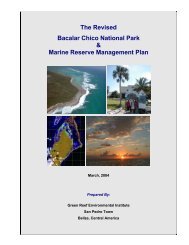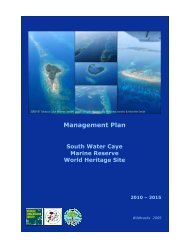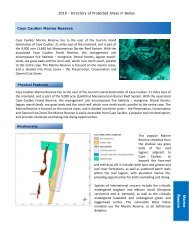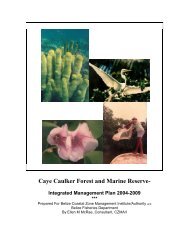Management Plan - Glover's Reef Marine Reserve
Management Plan - Glover's Reef Marine Reserve
Management Plan - Glover's Reef Marine Reserve
You also want an ePaper? Increase the reach of your titles
YUMPU automatically turns print PDFs into web optimized ePapers that Google loves.
3. Conservation <strong>Plan</strong>ning<br />
Glovers <strong>Reef</strong> <strong>Marine</strong> <strong>Reserve</strong> – <strong>Management</strong> <strong>Plan</strong><br />
Conservation planning for Glover’s <strong>Reef</strong> <strong>Marine</strong> <strong>Reserve</strong> is detailed in the<br />
proceedings of the Glover’s <strong>Reef</strong> Seascape Species Selection Workshop<br />
(Gibson, Hoare, Strindberg and Agrosa, 2004). The Seascape Species<br />
Approach is a wildlife-based strategy for defining and conserving the integrity<br />
of wild landscapes. The approach uses a group of surrogate species, called<br />
Seascape Species, as conservation targets, with the belief that meeting the<br />
needs of this suite will help conserve the composition of the seascape as a whole, the<br />
configuration of the seascape (how elements are arranged and connected), and ecological<br />
processes occurring at a seascape scale. The approach also helps conservationists to define<br />
the extent of the seascape based on the needs of the most demanding species, define<br />
ecologically appropriate management units, identify where and when conservation conflicts<br />
occur, and structure and prioritise conservation actions accordingly.<br />
The Living Seascape programme fits within the conservation planning criteria required by the<br />
National Protected Areas System <strong>Plan</strong>, identifying a series of conservation targets to represent<br />
the biodiversity of the protected area, highlighting threats and concerns, and developing<br />
strategies for incorporation into management programmes.<br />
The following project goals were defined during the development of the conservation planning<br />
activities:<br />
To conserve all species and habitats in order to preserve Glover’s <strong>Reef</strong>’s diversity &<br />
productivity<br />
To provide an ecological basis for functional seascape boundaries<br />
To focus conservation actions on key threats, efficiently allocating scarce conservation<br />
resources<br />
To use a wildlife-focused strategies to reconcile wildlife needs and human welfare<br />
3.1 Conservation Targets<br />
3.1.1 Identification of Conservation Targets<br />
The WCS Seascapes Programme (based on the Living Landscapes Programme) focuses on<br />
target species, and defining their population and habitat requirements to determine the<br />
seascape needs required for long term viability - of both the conservation targets, and of the<br />
underlying ecological processes on which they depend.<br />
Seascape Species are defined by their use of large, ecologically diverse areas, the important<br />
roles they play in maintaining the structure and function of natural ecosystems, and their<br />
susceptibility to human alteration of wild landscapes. As seascape species require large,<br />
diverse, minimally impacted areas, it is hypothesized that meeting their needs will provide<br />
substantial protection for the species with which they co-occur as well as for the marine<br />
ecosystems on which both depend. Additional conservation targets are selected on criteria<br />
such as endemism and species rarity.<br />
Wildtracks / Wildlife Conservation Society, 2007 60






